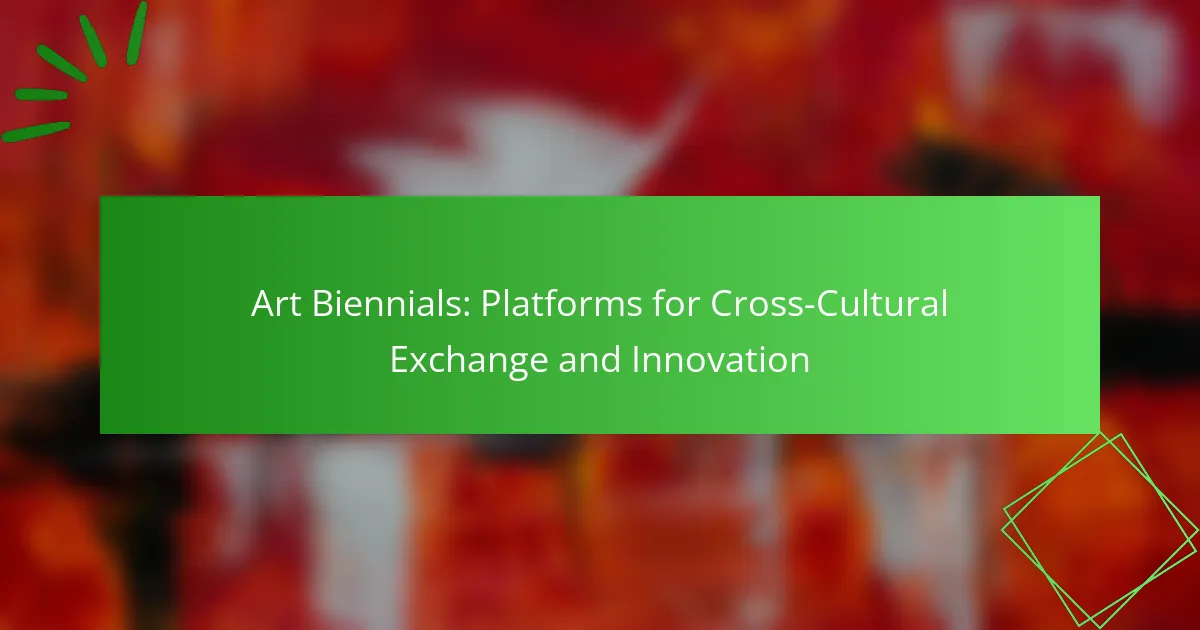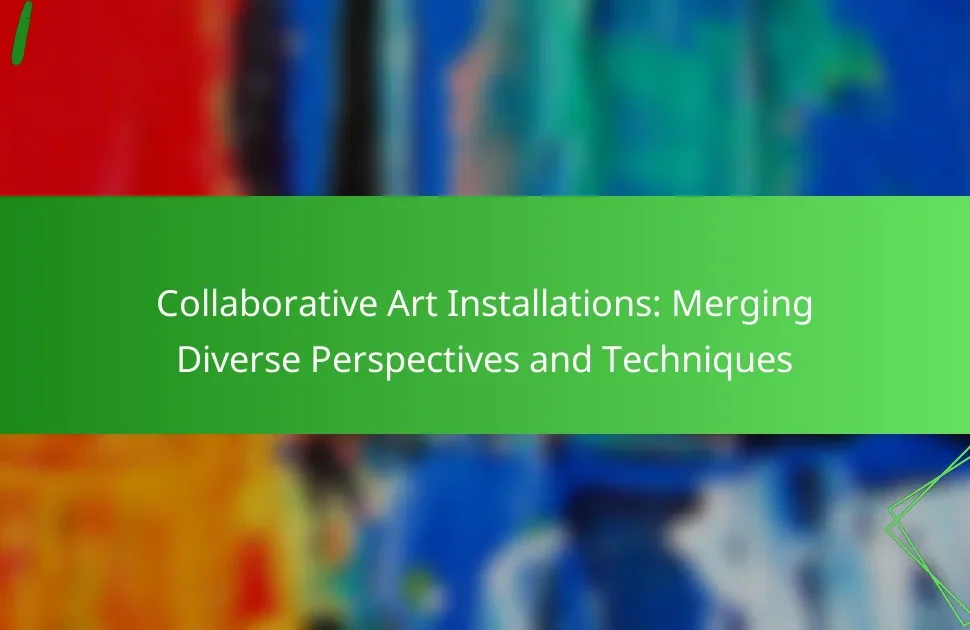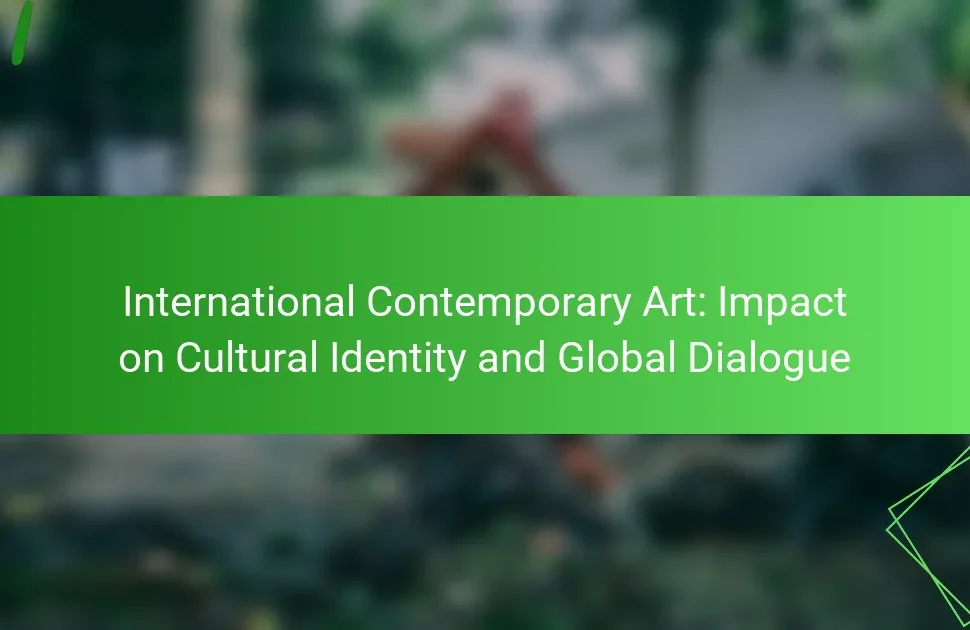Art biennials serve as vital platforms for cross-cultural exchange and innovation, connecting diverse artists and communities. They facilitate dialogue through exhibitions, workshops, and panel discussions. In 2025, these events are showcasing innovative practices and integrating technology to enhance audience engagement. However, challenges like funding instability and global political tensions threaten their role in fostering collaboration and social change.
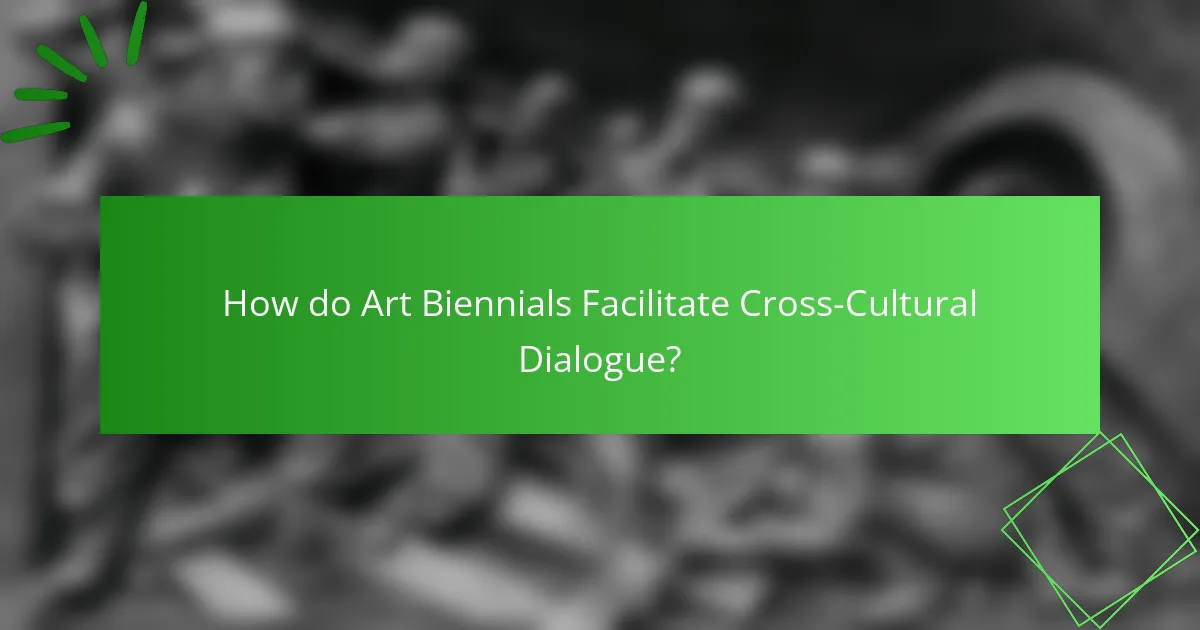
How do Art Biennials Facilitate Cross-Cultural Dialogue?
Art biennials facilitate cross-cultural dialogue by providing a platform for diverse artists to share their perspectives. These events encourage collaboration, foster understanding, and highlight cultural differences. Through exhibitions, panel discussions, and workshops, they promote innovative ideas and creative exchange. Art biennials serve as a bridge, connecting communities and stimulating conversations that transcend geographical boundaries.
What Role Do Curators Play in Shaping Cultural Narratives?
Curators play a crucial role in shaping cultural narratives by selecting and presenting artworks that reflect diverse perspectives. They facilitate dialogue between artists and audiences, fostering cross-cultural exchange. Through their choices, curators highlight underrepresented voices and challenge dominant narratives, enriching the cultural landscape. Their unique ability to interpret and contextualize art influences public perception and understanding of cultural issues.
How Are Local Artists Represented on Global Platforms?
Art biennials serve as vital platforms for local artists to gain international visibility and engage in cross-cultural dialogue. These events showcase diverse artistic expressions, fostering innovation and collaboration among global audiences.
Participation in art biennials allows local artists to connect with curators, collectors, and art enthusiasts, enhancing their professional networks. For instance, the Venice Biennale highlights emerging talents, enabling them to present their work on a prestigious stage.
Moreover, art biennials often emphasize themes relevant to local contexts, allowing artists to address global issues through their unique perspectives. This representation not only elevates local narratives but also enriches the global art discourse.
In summary, art biennials are crucial for local artists, providing opportunities for representation, networking, and cultural exchange on a global scale.
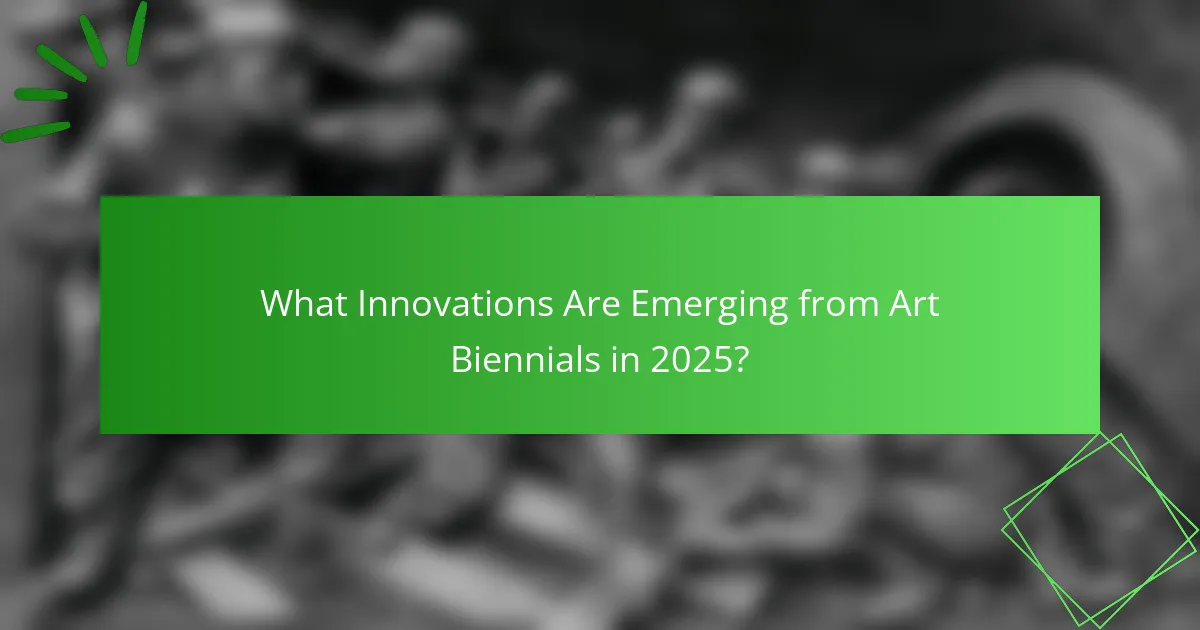
What Innovations Are Emerging from Art Biennials in 2025?
Art biennials in 2025 are showcasing innovative practices that foster cross-cultural exchange. These events are integrating technology, such as virtual reality and augmented reality, enhancing audience engagement. Artists are collaborating globally, creating works that address social issues and environmental concerns. The rise of interactive installations is transforming viewer experiences, making art more accessible and participatory. Additionally, sustainability is a key focus, with biennials adopting eco-friendly practices in their operations.
Which Technologies Are Transforming the Exhibition Experience?
Technologies such as augmented reality, virtual reality, interactive installations, and mobile applications are transforming the exhibition experience. These innovations enhance engagement, facilitate cross-cultural exchange, and foster innovation at art biennials. For example, augmented reality allows visitors to interact with artworks in immersive ways, while mobile applications provide personalized tours and real-time information. As a result, these technologies create a more dynamic and inclusive environment for diverse audiences.
How Are Virtual and Hybrid Formats Expanding Accessibility?
Virtual and hybrid formats are significantly expanding accessibility in art biennials by reaching wider audiences. These formats allow participation beyond geographical limitations, enabling global engagement. For instance, online exhibitions and livestreamed events provide access to diverse cultural expressions. As a result, artists and audiences can connect without physical barriers, fostering cross-cultural dialogue and innovation. This shift enhances the inclusivity of art biennials, allowing for broader representation and participation.
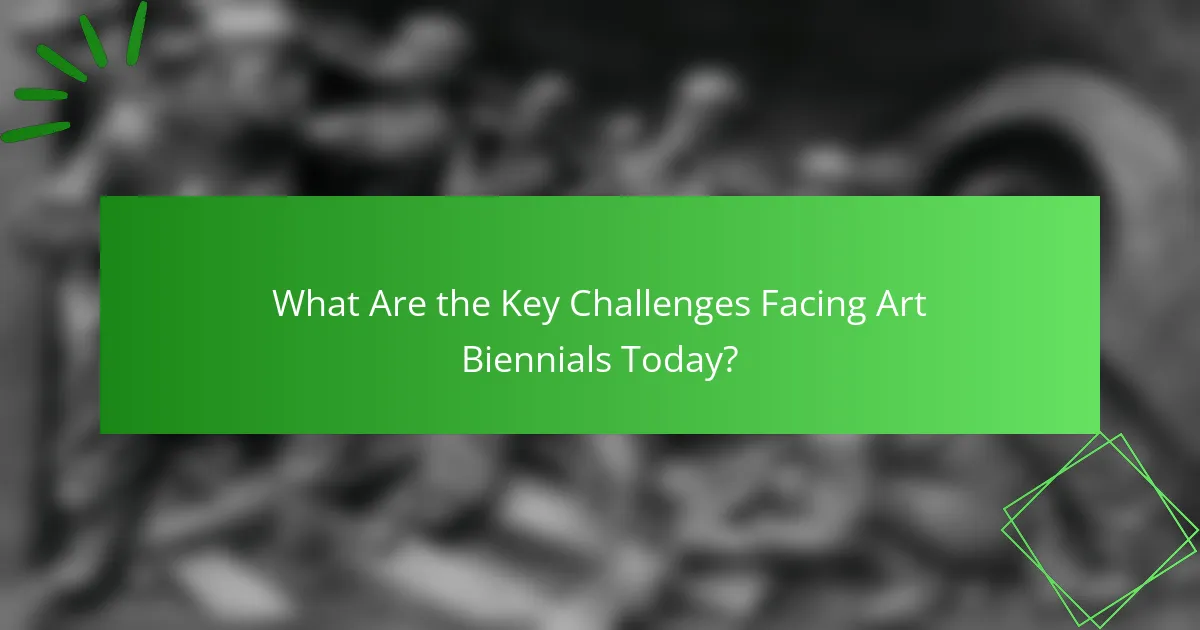
What Are the Key Challenges Facing Art Biennials Today?
Art biennials face challenges such as funding instability, audience engagement, and global political tensions. These factors hinder their role as platforms for cross-cultural exchange and innovation.
Funding instability affects the sustainability of art biennials, leading to reduced programming and outreach. Audience engagement remains a challenge, as curators strive to attract diverse demographics while remaining relevant. Global political tensions can restrict participation and influence the thematic direction of exhibitions, impacting the overall experience.
Additionally, the rise of digital art and virtual exhibitions presents both opportunities and challenges. Biennials must adapt to incorporate technology while maintaining the essence of in-person experiences. The competition among biennials for attention and resources also intensifies, requiring innovative approaches to capture interest and foster collaboration.
How Do Economic Factors Influence Participation and Attendance?
Economic factors significantly influence participation and attendance at art biennials by affecting accessibility and funding. Economic conditions impact ticket prices, travel costs, and the availability of sponsorships. For instance, during economic downturns, attendance may decline as individuals and institutions prioritize budgets. Conversely, robust economic growth can enhance participation through increased funding for cultural initiatives. Additionally, local economic health can affect the attractiveness of biennials, influencing both visitor numbers and artist involvement.
What Environmental Concerns Are Associated with Large-Scale Events?
Large-scale events like art biennials often raise significant environmental concerns. These events can lead to increased carbon emissions due to travel, waste generation from materials and food, and resource depletion in host cities.
The influx of visitors can strain local infrastructure, leading to pollution and habitat disruption. Additionally, temporary structures and installations may contribute to waste if not managed sustainably.
Art biennials can also promote environmental awareness through thematic exhibitions, encouraging discussions on sustainability and ecological responsibility. However, the overall environmental impact remains a critical consideration for organizers and attendees alike.
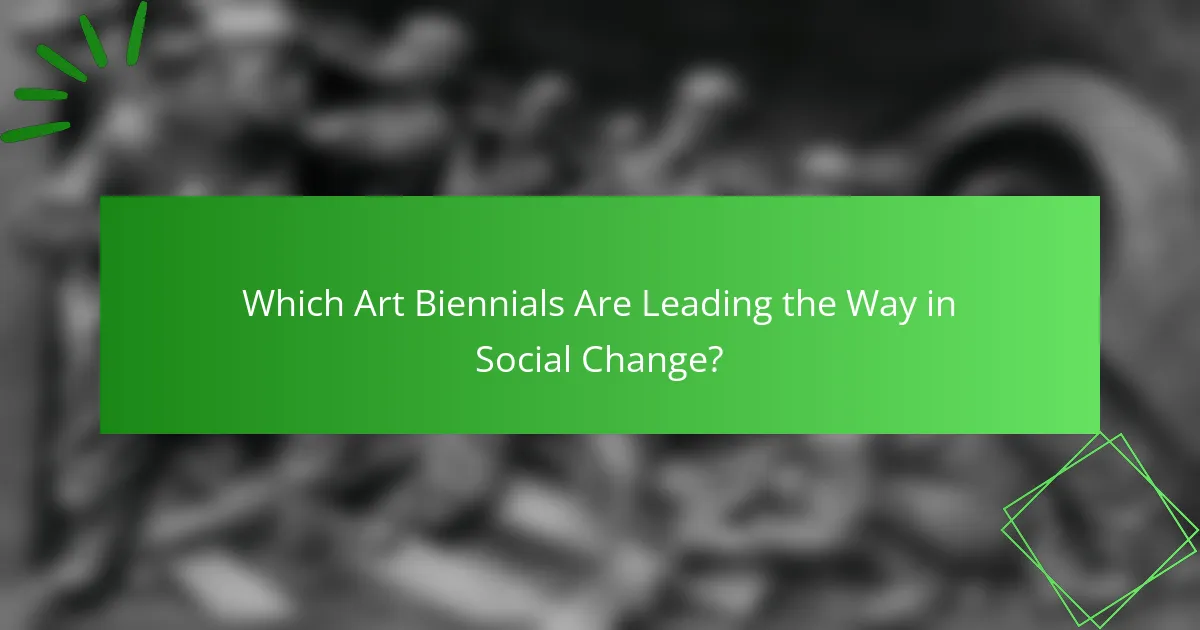
Which Art Biennials Are Leading the Way in Social Change?
Art biennials are increasingly driving social change by fostering dialogue and collaboration among diverse cultures. Notable examples include the Venice Biennale, which highlights global issues through contemporary art, and the Istanbul Biennial, known for its focus on social justice themes. The Berlin Biennale champions marginalized voices, while the Sydney Biennale emphasizes Indigenous perspectives. Each event serves as a platform for artists to engage with pressing societal challenges, promoting awareness and innovation. These initiatives illustrate how art can inspire action and transformation in communities worldwide.
How Do Specific Biennials Address Local Issues Through Art?
Art biennials address local issues through art by fostering community engagement and dialogue. They serve as platforms for artists to reflect on social, political, and environmental challenges specific to their regions. For instance, many biennials incorporate local narratives, promoting cultural identity and awareness.
These events often collaborate with local organizations, amplifying voices that might otherwise go unheard. By showcasing diverse perspectives, biennials encourage cross-cultural exchange and innovation, ultimately driving social change. Furthermore, they provide opportunities for workshops and discussions, allowing communities to actively participate in the artistic process.
Art biennials can also attract tourism, generating economic benefits for local economies. They create spaces for critical conversations, making art a catalyst for addressing pressing local issues. Overall, these biennials play a vital role in shaping community resilience and identity through the transformative power of art.
What Impact Do Art Biennials Have on Community Engagement?
Art biennials significantly enhance community engagement by fostering participation and collaboration among diverse groups. These events create platforms for local artists and international creators to connect, share ideas, and innovate.
Art biennials often include workshops, discussions, and interactive installations that invite community members to engage directly with the art. As a result, they promote cultural exchange and encourage dialogue on social issues.
Moreover, these events can stimulate local economies by attracting visitors and increasing tourism. Communities benefit from increased visibility and opportunities for local artists to showcase their work, thereby enhancing cultural identity and pride.
In summary, art biennials serve as vital catalysts for community engagement, enriching cultural landscapes and fostering connections across various demographics.
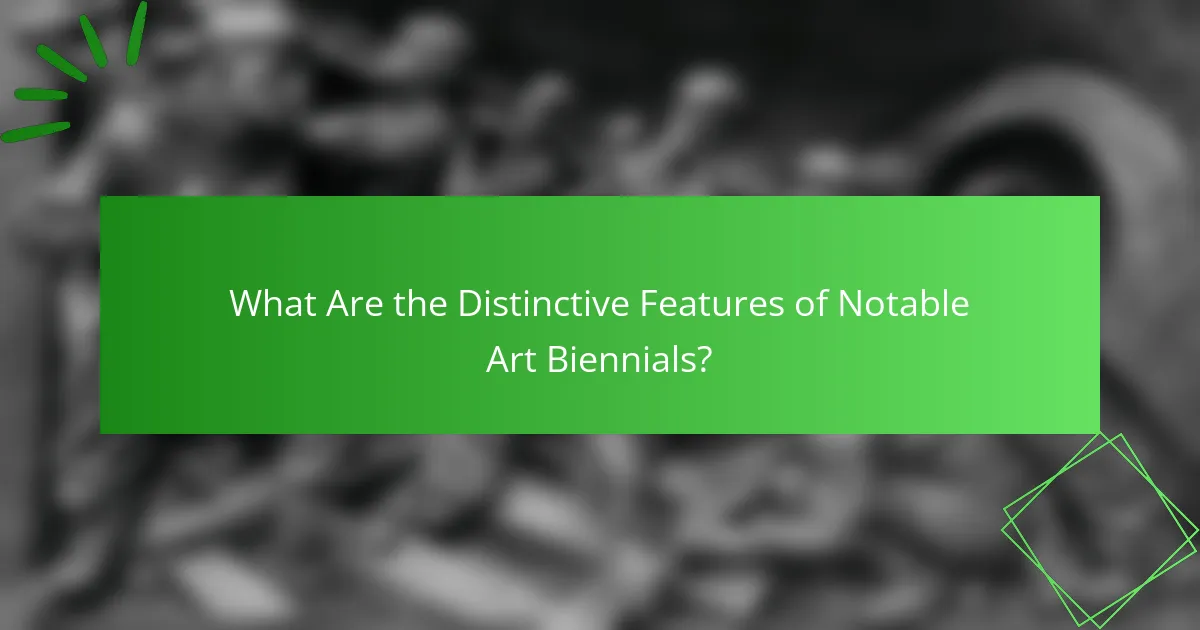
What Are the Distinctive Features of Notable Art Biennials?
Notable art biennials showcase distinctive features such as diverse international participation, innovative curatorial practices, and unique thematic focuses. These events foster cross-cultural dialogue and showcase emerging trends in contemporary art. Additionally, they often emphasize local contexts while engaging global narratives, creating platforms for artists to experiment and collaborate. For example, the Venice Biennale highlights national pavilions that reflect cultural identities, while the Istanbul Biennial integrates social issues into its exhibitions, demonstrating how biennials adapt to their environments.
How Does the Venice Biennale Set Trends for Global Art Events?
The Venice Biennale significantly influences global art events by showcasing innovative practices and fostering cross-cultural dialogue. Its international platform attracts diverse artists, curators, and audiences, setting trends that resonate worldwide. The Biennale’s unique ability to highlight emerging artists and themes creates a ripple effect, inspiring future exhibitions and art fairs globally. As a result, it remains a pivotal reference point for contemporary art movements and cultural exchanges.
What Makes Documenta a Unique Platform for Artistic Expression?
Documenta stands out as a unique platform for artistic expression due to its commitment to innovative, interdisciplinary approaches. It fosters dialogue among diverse cultural perspectives, encouraging collaboration and experimentation. Documenta’s emphasis on social and political themes sets it apart, inviting artists to engage with pressing global issues. Additionally, its temporary nature allows for a fresh exploration of contemporary art, making each edition a distinct experience that challenges traditional boundaries.
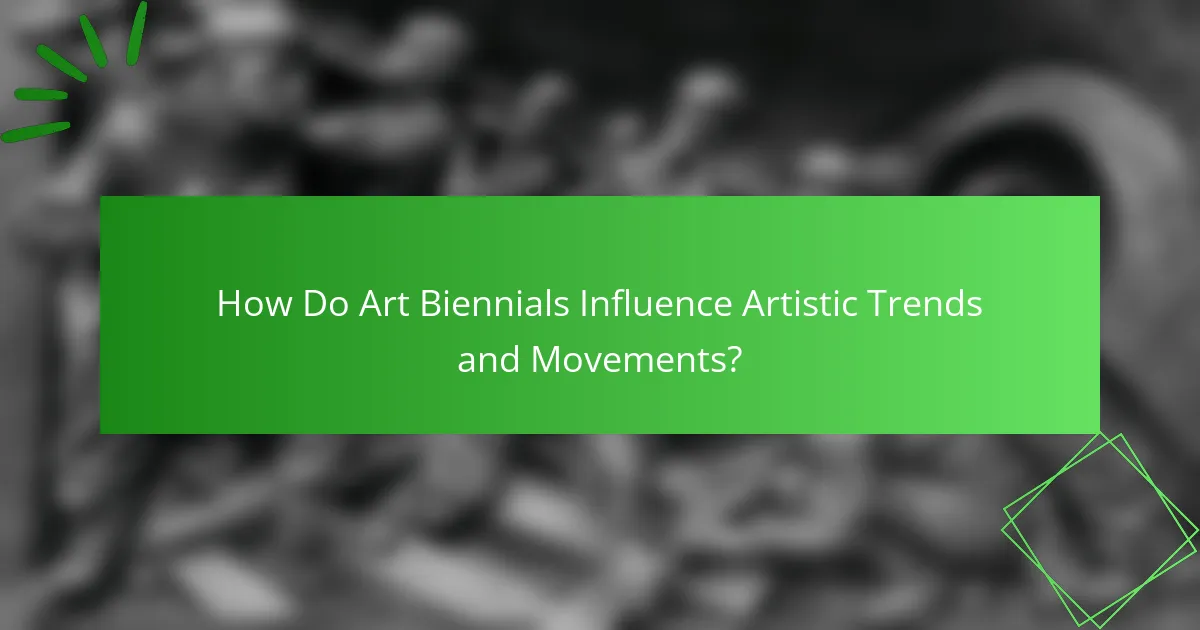
How Do Art Biennials Influence Artistic Trends and Movements?
Art biennials significantly shape artistic trends and movements by fostering global dialogue and collaboration. They serve as vital platforms for artists to showcase innovative works that challenge traditional norms. Biennials often reflect contemporary issues, influencing the direction of art through diverse cultural narratives. For instance, the Venice Biennale highlights emerging artists, setting trends that resonate worldwide. These events create opportunities for cross-cultural exchange, enabling artists to connect and inspire one another.
Which Themes Are Predominantly Explored in Recent Biennials?
Recent biennials predominantly explore themes of cultural identity, environmental sustainability, and technological innovation. These themes foster dialogue among diverse communities and challenge traditional art practices.
Cultural identity is often highlighted through global representation, showcasing artists from various backgrounds. Environmental sustainability addresses pressing ecological issues, encouraging artists to engage with climate change and conservation. Technological innovation reflects the impact of digital media, pushing the boundaries of artistic expression.
As a result, these themes create dynamic platforms for cross-cultural exchange, enriching the contemporary art landscape. The focus on these attributes enhances the relevance and accessibility of biennials in today’s society.
How Do Art Biennials Shape the Careers of Emerging Artists?
Art biennials significantly enhance the careers of emerging artists by providing visibility and networking opportunities. These events create platforms for artists to showcase their work to international audiences and critics, fostering cross-cultural exchange.
Emerging artists often gain exposure through curated exhibitions, which can lead to representation by galleries and invitations to future events. For instance, participation in a well-known biennial can elevate an artist’s profile, resulting in increased sales and commissions.
Moreover, biennials facilitate collaborations and dialogues among artists, curators, and collectors. This interaction can inspire innovation, pushing artists to explore new ideas and techniques.
The unique attribute of biennials is their ability to connect artists from diverse backgrounds, enabling them to share their narratives and experiences. This cross-pollination of ideas enriches the global art scene and supports the growth of emerging talent.

What Best Practices Can Ensure the Success of Future Art Biennials?
Successful art biennials depend on strategic planning, community engagement, and diverse programming. Incorporating local artists fosters cross-cultural exchange, while innovative themes encourage creative exploration. Collaborating with educational institutions enhances accessibility and outreach, attracting wider audiences. Investing in sustainable practices ensures long-term viability and supports environmental awareness in the art community.
How Can Organizers Enhance Visitor Experience and Engagement?
Organizers can enhance visitor experience and engagement by incorporating interactive elements, diverse programming, and accessible information. Engaging art installations encourage participation and dialogue among visitors. Offering workshops and panel discussions fosters cross-cultural exchange. Additionally, utilizing technology, such as mobile apps, improves navigation and provides real-time updates on events. Creating inclusive environments allows for a broader audience engagement, enhancing the overall impact of the biennial.
What Strategies Can Be Employed to Foster Sustainable Practices?
Art biennials can foster sustainable practices through collaborative initiatives, educational programs, and eco-friendly exhibition designs. These platforms promote awareness of environmental issues and inspire innovative solutions.
1. Collaborative initiatives: Biennials can partner with local communities and organizations to implement sustainable projects, enhancing cultural exchange and environmental stewardship.
2. Educational programs: Hosting workshops and seminars on sustainability encourages artists and attendees to adopt eco-friendly practices in their work and daily lives.
3. Eco-friendly exhibition designs: Utilizing sustainable materials and energy-efficient technologies reduces the environmental impact of art installations.
4. Community engagement: Involving local artists and communities in the planning process fosters a sense of ownership and responsibility towards sustainability.
By integrating these strategies, art biennials can become vital agents of change in promoting sustainable practices globally.
